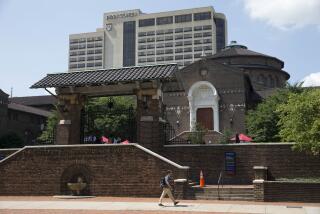Army May Have Made a Grave Error When It Buried Custer : History: Remains at West Point may not be the infamous soldier killed at Little Bighorn, historians and anthropologists say.
WEST POINT, N.Y. — It’s no riddle that Gen. Ulysses S. Grant is the man buried in Grant’s Tomb. But there is a mystery behind who is buried in the grave of the man Grant sent to fight the Indians.
It may not be Gen. George Armstrong Custer, who died in 1876 along with his 267 soldiers at the hands of Sioux and Cheyenne Indians at the Little Bighorn in Montana. Instead, Custer’s grave at the U.S. Military Academy might be the Tomb of the Unknown Soldier, historians and anthropologists say.
It’s possible that in West Point’s cemetery, under the noses of America’s top military instructors, an enlisted man is impersonating an officer.
“It would be ironic if some buck private were buried up there at West Point,” said forensic anthropologist Clyde Snow, who examined newly found bones at Little Bighorn in 1985. Especially ironic, since Custer’s wife, Elizabeth, was buried alongside in 1933.
“I’ve often thought in my own warped way that Libby was sure surprised if there was some corporal lying beside her,” said Doug McChristian, chief historian at Custer Battlefield National Monument in Montana.
While at Little Bighorn, Snow looked into the records of Custer’s burial and his exhumation a year later, when his supposed bones were moved to West Point. Custer graduated from West Point in 1861 at the bottom of his class.
“I have a suspicion they got the wrong body,” said Snow, of Norman, Okla. “The only way to put those suspicions to bed would be to look at the bones interred at West Point and see how they gibe with information we have on Gen. Custer.”
As a professional challenge, Snow would like to dig Custer up and try to identify the remains. But as a man who loves myths, he also likes the idea of maintaining the mystery over the occupant of Custer’s grave.
“The thought that it might not be Custer is too delicious to put to rest,” Snow said. If someone other than Custer was buried there, “they’d probably put the poor guy out somewhere.”
The myth will likely remain because the Custer family will not permit an exhumation.
“Absolutely not,” George A. Custer III of Pebble Beach, a retired Army colonel and great-grandnephew of Custer, said before he died last month.
Custer’s grave is one of the most popular among West Point visitors. A stone shaped like Washington’s Monument stands over the grave, with bronze plaques depicting the Battle of the Little Bighorn. Even today, Custer buffs occasionally leave flowers on the grave.
“It’s a tribute to Custer whether his bones are there or not,” said Maj. Ed Evans, West Point spokesman.
Most of the soldiers killed at Little Bighorn were not properly identified and were buried hastily in shallow graves. Over the years, animals and the elements scattered many of the bones, while tourists carted off others.
Custer got the most decent burial. He was laid in a fairly deep grave--18 inches. The body of Custer’s brother, Tom, was laid alongside. The bodies were covered with blankets and a canvas tarp. After it was filled in, the grave was covered with an Indian stretcher, which was weighted down with rocks.
Those efforts should have protected the bodies, leaving two full skeletons for a cavalry detachment that returned a year later to dig up Custer, Snow said.
The exhumation team did not find the stretcher, the rocks, the blankets or the canvas. The grave they believed was Custer’s contained only one skeleton. After exhuming it, the diggers discovered that the rotting uniform containing the skeleton bore a corporal’s name. They dug up a nearby grave which contained only a skull, rib cage and leg bone. The exhumation team decided those bones were Custer’s and shipped them to West Point for burial.
“It sounds like they just moved over to the next grave and said, ‘This is Custer,’ ” Snow said.
McChristian agrees that the exhumation team concluded they “got the right bones the second time but failed to say how they identified the remains any more thoroughly than the first ones.”
Evan Connell, author of the Custer biography “Son of the Morning Star,” agrees that the exhumation was an unprofessional job, but he thinks the second body dug up was Custer’s.
“My impression is they probably got it right the second time,” Connell said. A lock of auburn hair found with those remains was sent to Elizabeth Custer, who said it matched her husband’s, Connell said.
If the job of digging up Custer was bungled, the exhumation team shouldn’t be blamed, said Richard Hardorff of DeKalb, Ill., who published a book on the burials and exhumations at the Little Bighorn.
“Put yourself in their place,” Hardorff said. “You see the bones, you see skeletons, but you’re used to seeing a living person with a certain face, a certain manner of moving around, but all that’s gone. They did the best they could” to identify Custer’s bones.
Bruce Liddic of Syracuse, N.Y., who published a book about Custer’s burial, said there’s a slim chance “that out of pure dumb luck they got the right body, but I doubt it.”
So where’s Custer?
If not at West Point, his bones probably are mingled with enlisted men’s in a mass grave at Little Bighorn where exhumed remains were reburied in 1881, McChristian said.
“I think that as a soldier, Custer probably would not mind” being buried among his men, McChristian said.
Even if the exhumation team did find Custer’s grave, they sent only a partial skeleton to West Point. That means some of Custer’s bones probably wound up in the mass grave and some are “probably still out there on Last Stand Hill,” said National Parks Service archeologist Doug Scott.
The careless exhumation was typical of the times, said Scott, who headed digs at the Custer site in 1984 and 1985. A century ago, a tomb or monument to honor the dead was more important than preserving the human remains, he said.
“In the cultural context of the day, the attitude about dying was to memorialize the death rather than worry about the corpus itself,” Scott said. “Their attitude was to go for a skull, maybe some ribs, an arm or a leg, and that was enough.”
The men under Capt. Michael Sheridan, who led the exhumation team, had doubts that the remains being packed for shipment to West Point were Custer’s. Sheridan ordered them to “nail the box up; it is all right as long as the people think so.”
Members of the Custer cult agree.
“I don’t think it makes a bit of difference” if the wrong remains were buried in Custer’s grave, said W. Donald Horn of Short Hills, N.J., who belongs to the group Little Big Horn Associates. “I think most of Custer’s bones remain out in Montana, anyway.”
The monument over Custer’s grave “may be more important than who’s buried there,” Scott said.
More to Read
Sign up for Essential California
The most important California stories and recommendations in your inbox every morning.
You may occasionally receive promotional content from the Los Angeles Times.










